Influences on High-Voltage Electro Pulse Boring in Granite
Abstract
:1. Introduction
2. Theory and Model
2.1. High-Voltage EPB Rock Breaking Systems
2.2. Mathematical Model of High-Voltage Electro Pulse Discharge in Rock
2.3. EPB Numerical Simulation Model
2.3.1. Building the Simulation Model
2.3.2. Definition and Solution of the Simulation Model
3. Results and Discussion
3.1. Influence of Granite Composition on EPB
3.2. Influence of Electrode Spacing on EPB
3.3. Influence of Electrode Shape on EPB
3.4. Influence of Electrical Parameters on EPB
4. Conclusions
5. Patents
Author Contributions
Acknowledgments
Conflicts of Interest
Nomenclature
| L | Inductive inductance, H |
| i | Current in the loop, A |
| Rz | Circuit resistance, Ω |
| Rtd | Resistance of plasma channel, Ω |
| Uc | Instantaneous voltage of capacitor, V |
| C | Energy storage capacitance, F |
| U0 | Charge voltage, V |
| Ktd | Resistance coefficient, V·S1/2/m |
| ltd | Length of the plasma channel, m |
| Ptd | Power injected into the plasma channel, W |
| Wtd | Energy injected into the plasma channel, J |
| τ | Discharge relaxation time of the rock, s |
| T | External discharge time, s |
| ε0 | Vacuum permittivity, F/m |
| εr | Relative permittivity |
| P | Polarization intensity vector, C/m2 |
| ρ | Electric field density in space, C/m3 |
References
- Schiegg, H.O.; Rødland, A.; Zhu, G.Z.; Yuen, D. Electro-Pulse-Boring (EPB): Novel Super-Deep Drilling Technology for Low Cost Electricity. J. Earth Sci. 2015, 26, 37–46. [Google Scholar] [CrossRef]
- Yan, T.; Du, J.Y.; Li, W.; Bi, X.L.; Yao, S.L. Synthesizing Comment on Efficient Rock Fragmentation Method in Frontier Drilling Technology. Oil Field Equip. 2012, 41, 50–55. [Google Scholar]
- Ge, Z.L.; Deng, K.; Lu, Y.Y.; Cheng, L.A.; Zuo, S.J.; Tian, X.D. A novel method for borehole blockage removal and experimental study on a hydraulic self-propelled nozzle in underground coal mines. Energies 2016, 9, 698. [Google Scholar] [CrossRef]
- Lam, S.S.; Chase, A.H. A review on waste to energy processes using microwave pyrolysis. Energies 2012, 5, 4209–4232. [Google Scholar] [CrossRef]
- Biela, J.; Marxgut, C.; Bortis, D.; Kolar, J.W. Solid state modulator for plasma channel drilling. IEEE Trans. Dielectr. Electr. Insul. 2009, 16, 1093–1099. [Google Scholar] [CrossRef]
- Cho, S.H.; Cheong, S.S.; Yokota, M.; Kaneko, K. The dynamic fracture process in rocks under high-voltage pulse fragmentation. Rock Mech. Rock Eng. 2016, 49, 3841–3853. [Google Scholar] [CrossRef]
- Andres, U. Electrical disintegration of rock. Miner. Proc. Extract. Metullargy Rev. 1995, 14, 87–110. [Google Scholar] [CrossRef]
- Fujita, T.; Yoshimi, I.; Shibayama, A.; Miyazaki, K.; Abe, K.; Sato, M.; Yen, W.T.; Svoboda, S.J. Crushing and liberation of materials by electrical disintegration. EJMP EP (Eur. J. Miner. Process. Environ. Prot.) 2001, 1, 113–122. [Google Scholar]
- Ito, M.; Owada, S.; Nishimura, T.; Ota, T. Experimental study of coal liberation: Electrical disintegration versus roll-crusher comminution. Int. J. Miner. Process. 2009, 92, 7–14. [Google Scholar] [CrossRef]
- Timoshkin, I.V.; Mackersie, J.W.; Macgregor, S.J. Plasma channel microhole drilling technology. In Proceedings of the IEEE International Pulsed Power Conference, Dallas, TX, USA, 15–18 June 2003; pp. 1336–1339. [Google Scholar]
- Kusaiynov, K.; Nussupbekov, B.R.; Shuyushbayeva, N.N.; Tanasheva, N.K.; Shaimerdenova, K.M.; Khassenov, A.K. On electric-pulse well drilling and breaking of solids. Tech. Phys. 2017, 62, 867–870. [Google Scholar] [CrossRef]
- Inoue, H.; Lisitsyn, I.V.; Akiyama, H. Drilling of hard rocks by pulsed power. IEEE Electr. Insul. Mag. 2000, 16, 19–25. [Google Scholar] [CrossRef]
- Bluhm, H.; Frey, W.; Giese, H.; Hoppe, P.; Schultheiss, C.; Strassner, R. Application of pulsed HV discharges to material fragmentation and recycling. IEEE Trans. Dielectr. Electr. Insul. 2000, 7, 625–636. [Google Scholar] [CrossRef]
- Vizir, V.A.; Kovalchuk, B.M.; Kharlov, A.V.; Kumpyak, E.V.; Chervyakov, V.V.; Shubkin, N.G.; Tsoy, N.V.; Zorin, V.B.; Kiselev, V.N.; Chupin, V.V. High-Voltage Pulsed Generator for Dynamic Fragmentation of Rocks. Rev. Sci. Instrum. 2010, 81, 308–311. [Google Scholar]
- He, M.B.; Jiang, J.B.; Huang, G.L.; Liu, J.; Li, C.Z. Disintegration of rocks based on magnetically isolated high voltage discharge. Rev. Sci. Instrum. 2013, 84, 61–70. [Google Scholar] [CrossRef] [PubMed]
- Ji, N.Y.; Pei, Y.L.; Yan, K.P.; Liu, C.G.; Zhang, Z.C. Development of High-voltage Pulse-transmission Electric Cable for Plasma Drill. Mach. Electron. 2012, 8, 7–10. [Google Scholar]
- Zhang, Z.C. Rock Fragmentation by Pulsed High Voltage Discharge and Drilling Equipment Development. Ph.D. Thesis, Zhejiang University, Hangzhou, China, 6 June 2013. [Google Scholar]
- Kurets, V.I.; Lopatin, V.V.; Noskov, M.D. Influence of local heterogeneities on discharge channel trajectory at electric pulse destruction of materials. J. Min. Sci. 2000, 36, 268–274. [Google Scholar] [CrossRef]
- Boev, S.; Vajov, V.; Jgun, D.; Levchenko, B.; Muratov, V.; Adam, A.; Uemura, K. Destruction of granite and concrete in water with pulse electric discharges. In Proceedings of the IEEE International Pulsed Power Conference, Columbia, MO, USA, 27–30 June 1999; pp. 1369–1371. [Google Scholar]
- Wang, E.; Shi, F.N.; Manlapig, E. Experimental and numerical studies of selective fragmentation of mineral ores in electrical comminution. Int. J. Miner. Process. 2012, 112, 30–36. [Google Scholar] [CrossRef]
- Andres, U.; Timoshkin, I.; Soloviev, M. Energy consumption and liberation of minerals in explosive electrical breakdown of ores. Miner. Process. Extract. Metall. 2013, 110, 149–157. [Google Scholar] [CrossRef]
- Van der Wielen, K.P.; Pascoe, R.; Weh, A.; Wall, F.; Rollinson, G. The influence of equipment settings and rock properties on high voltage breakage. Miner. Eng. 2013, 46, 100–111. [Google Scholar] [CrossRef]
- Lisitsyn, I.V.; Inoue, H.; Nishizawa, I.; Katsuki, S.; Akiyama, H. Breakdown and destruction of heterogeneous solid dielectrics by high voltage pulses. J. Appl. Phys. 1998, 84, 6262–6267. [Google Scholar] [CrossRef]
- Burkin, V.V.; Kuznetsova, N.S.; Lopatin, V.V. Dynamics of electro burst in solids: I. Power characteristics of electro burst. J. Phys. D Appl. Phys. 2009, 42, 235–241. [Google Scholar] [CrossRef]
- Burkin, V.V.; Kuznetsova, N.S.; Lopatin, V.V. Dynamics of electro burst in solids: II. Characteristics of wave process. J. Phys. D Appl. Phys. 2009, 42, 242–248. [Google Scholar] [CrossRef]
- Yan, F.Z.; Lin, B.Q.; Zhu, C.J.; Guo, C.; Zhou, Y.; Zou, Q.L.; Liu, T. Using high-voltage electrical pulses to crush coal in an air environment: An experimental study. Powder Tech. 2016, 298, 50–56. [Google Scholar] [CrossRef]
- Kao, K.C. New theory of electrical discharge and breakdown in low-mobility condensed insulators. J. Appl. Phys. 1984, 55, 752–755. [Google Scholar] [CrossRef]
- Mohammada, R.S.; Bahram, R.; Mehdi, I.; Hasan, R.M. Numerical simulation of high voltage electric pulse comminution of phosphate ore. Int. J. Min. Sci. Tech. 2015, 25, 473–478. [Google Scholar]

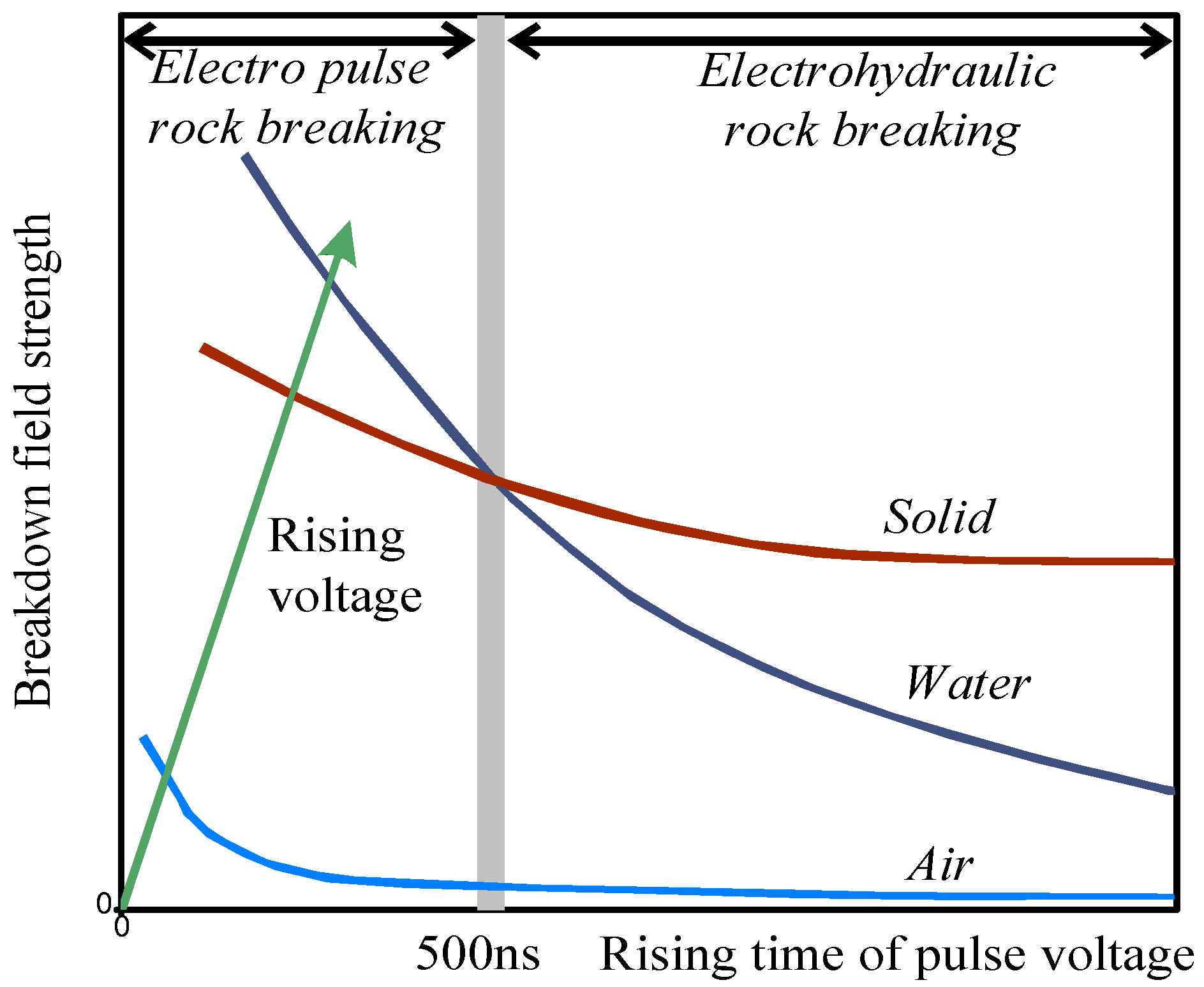


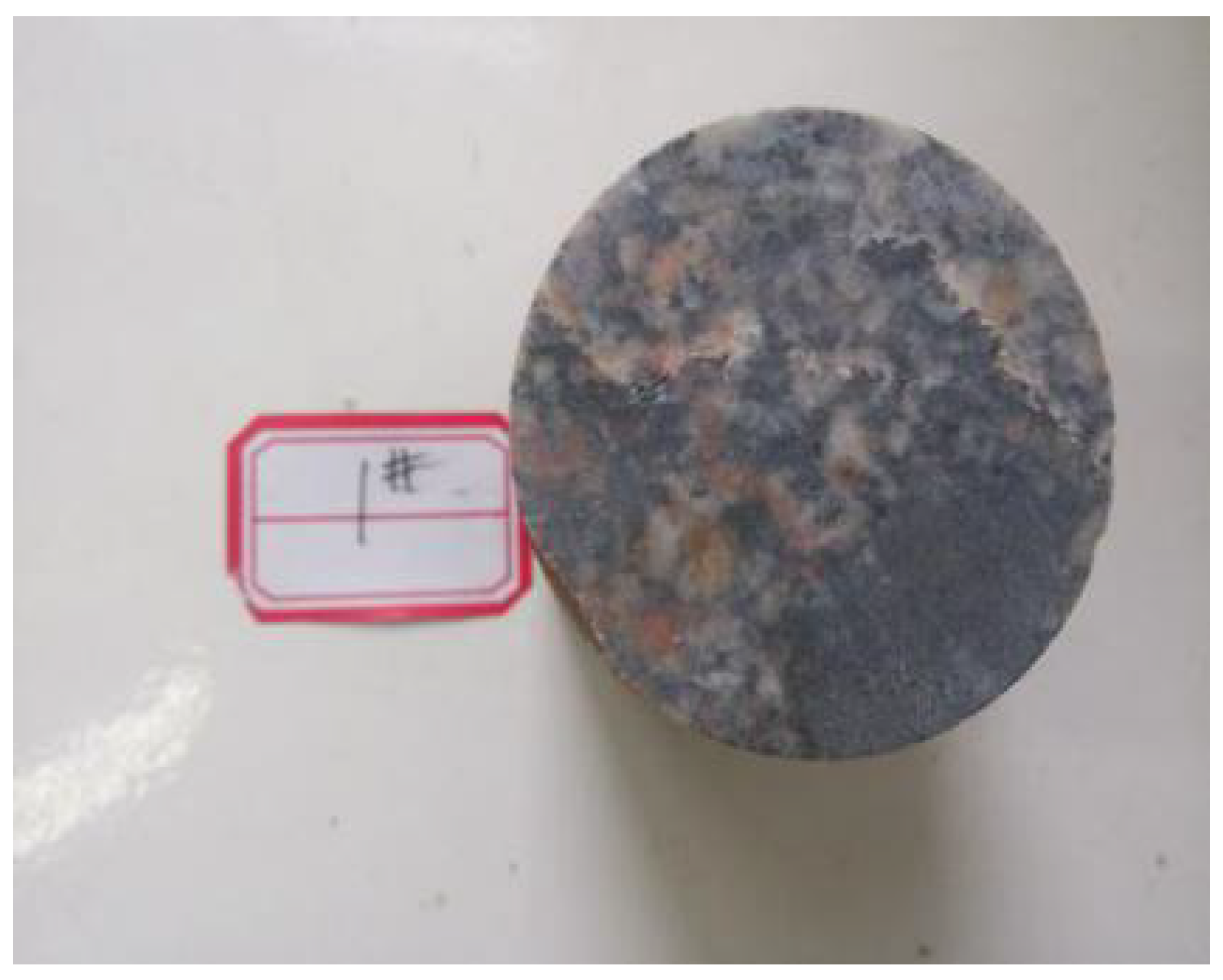
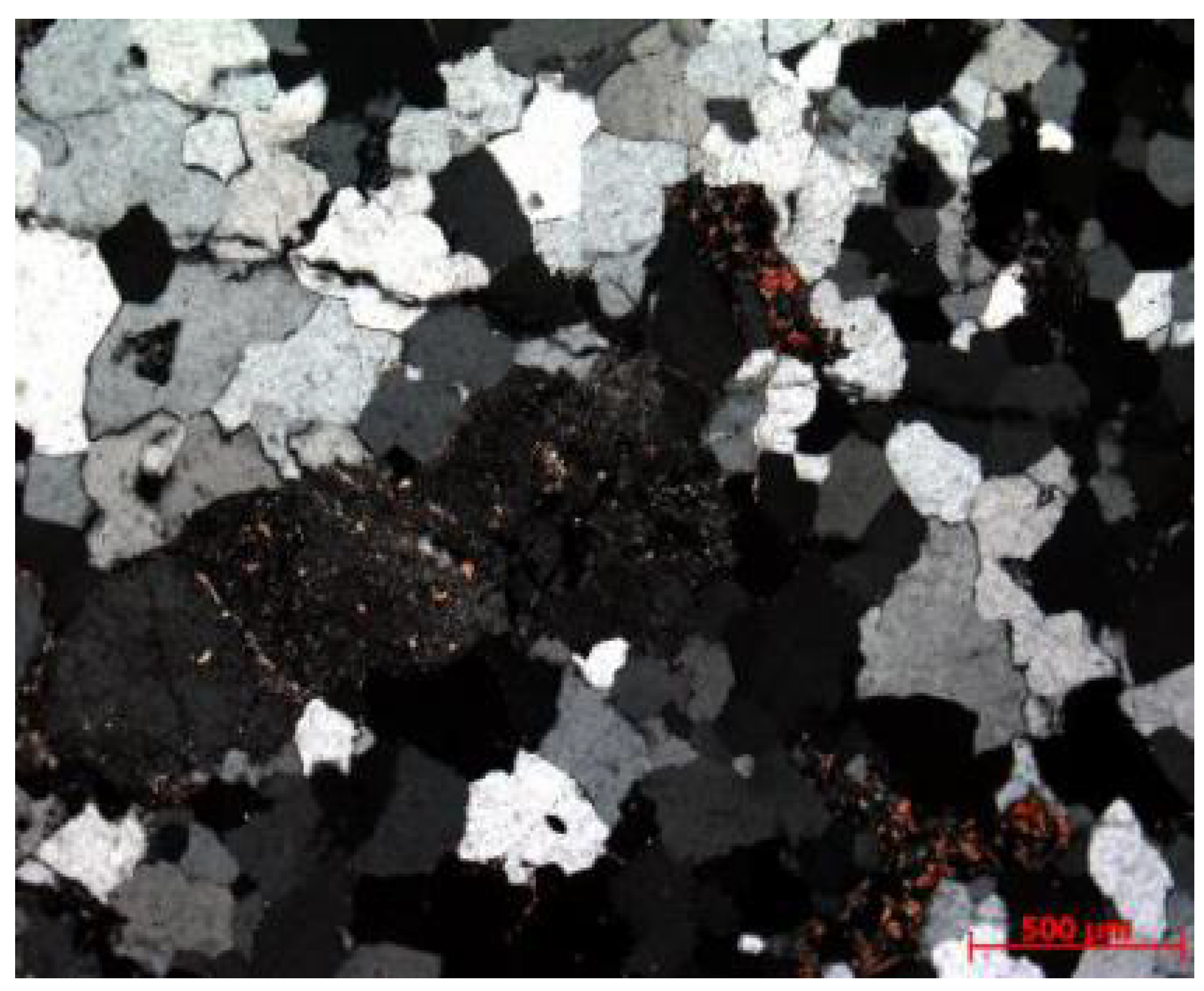
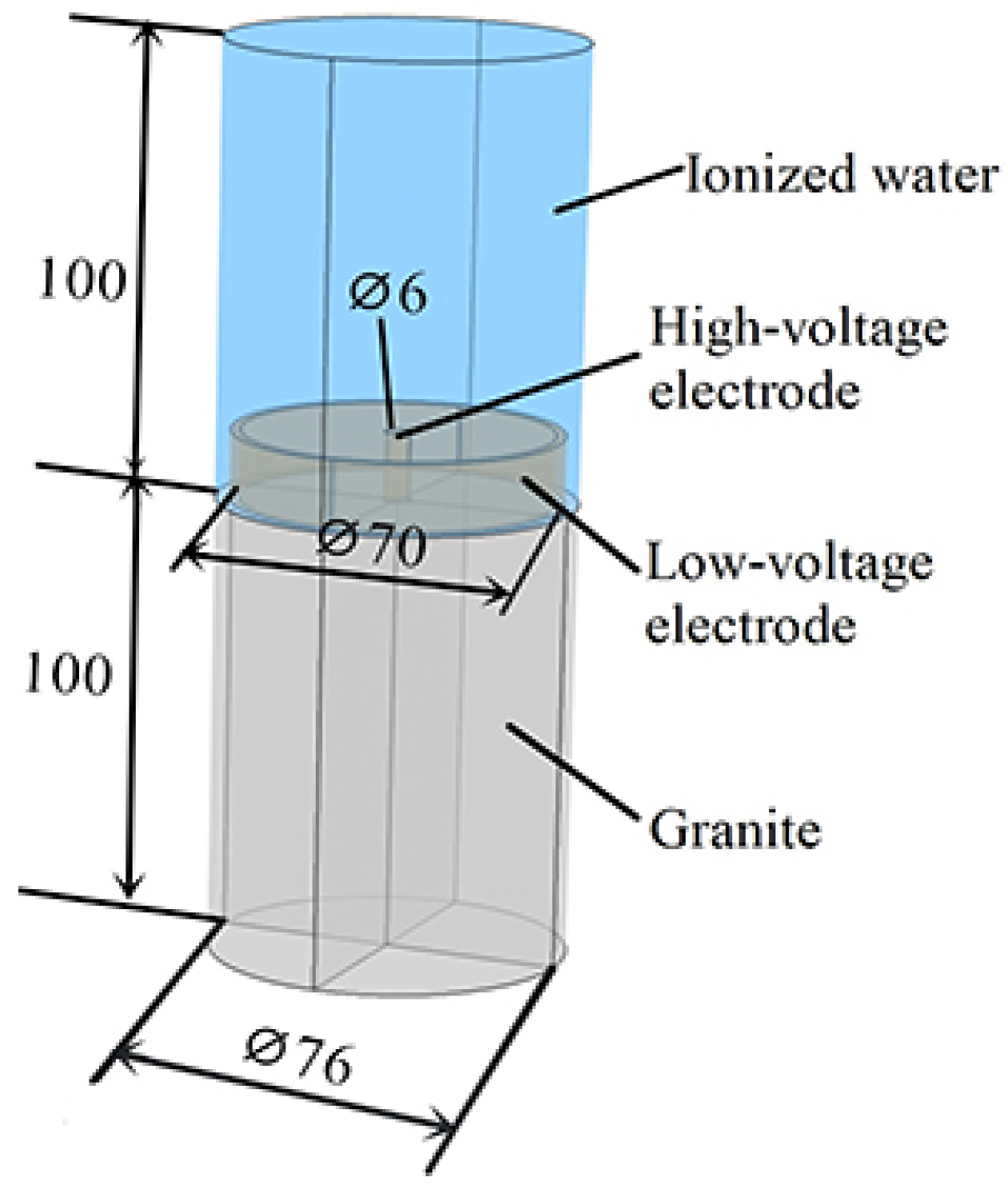
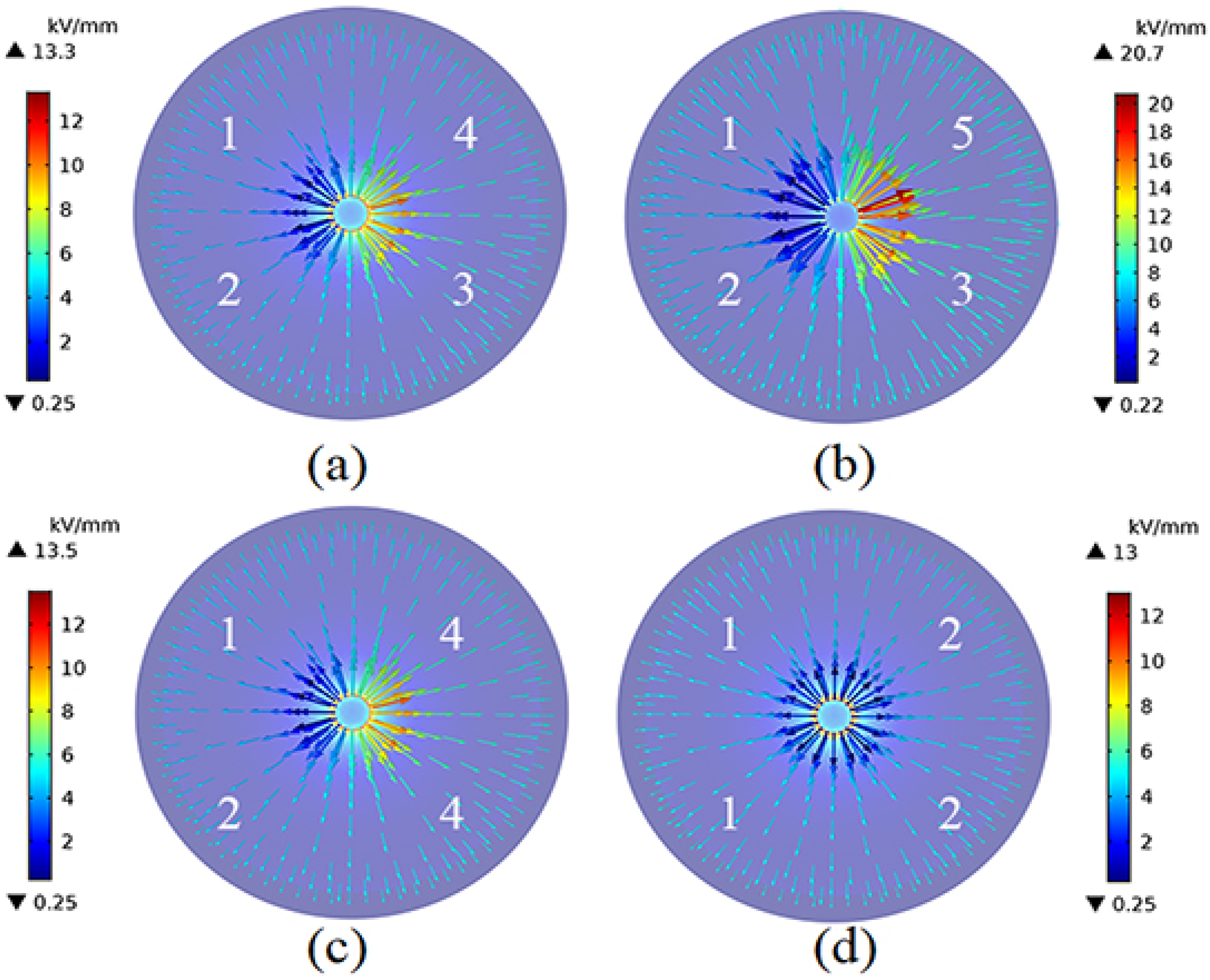
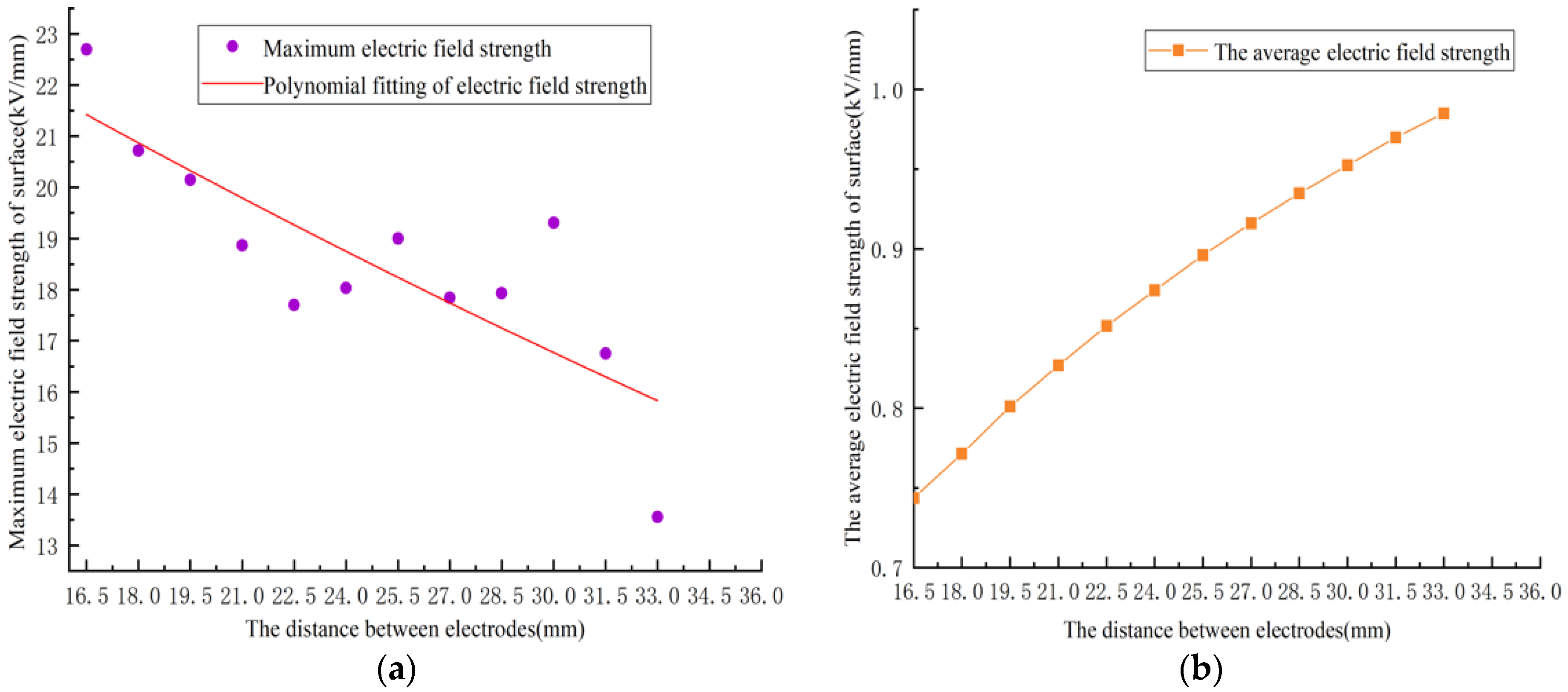
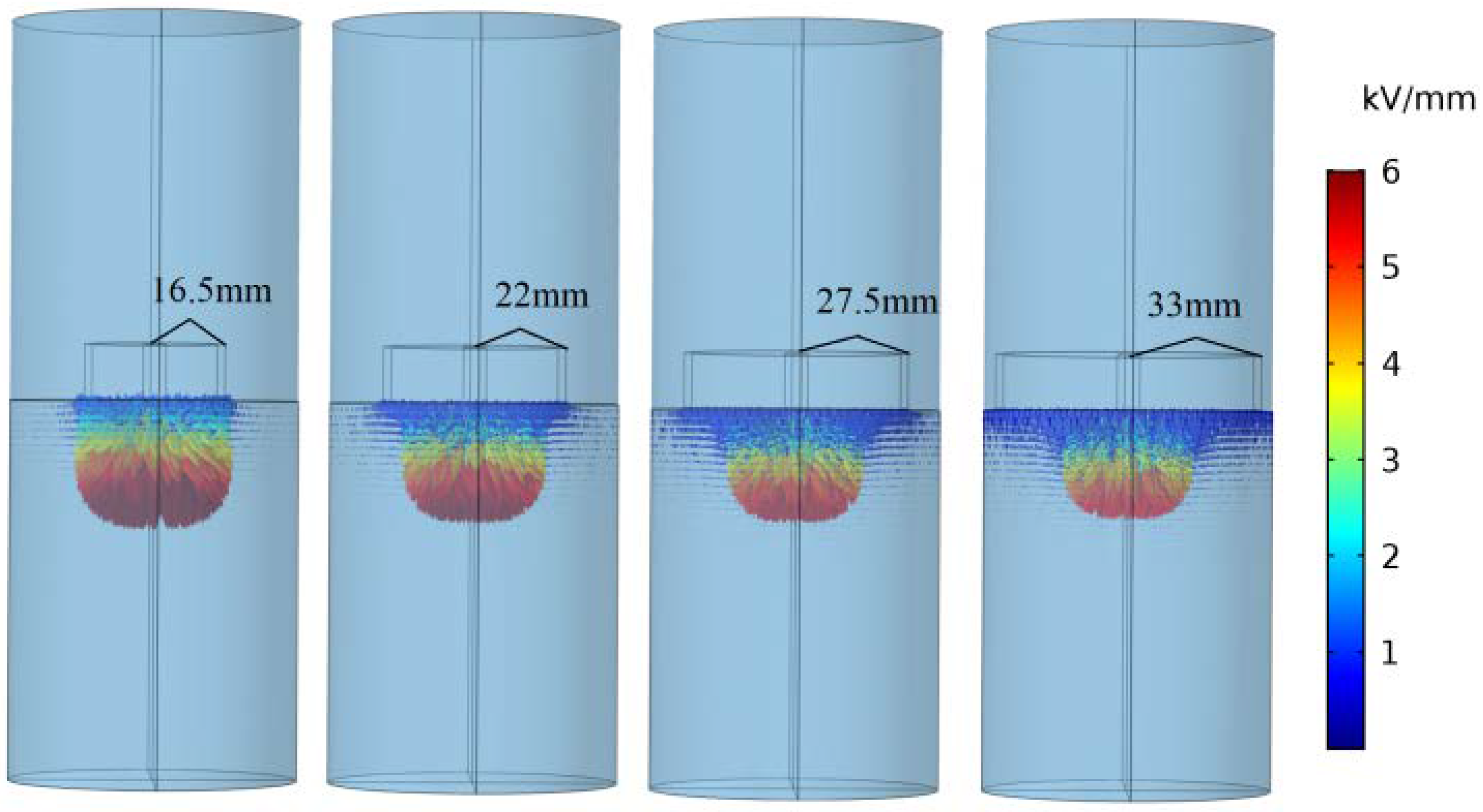
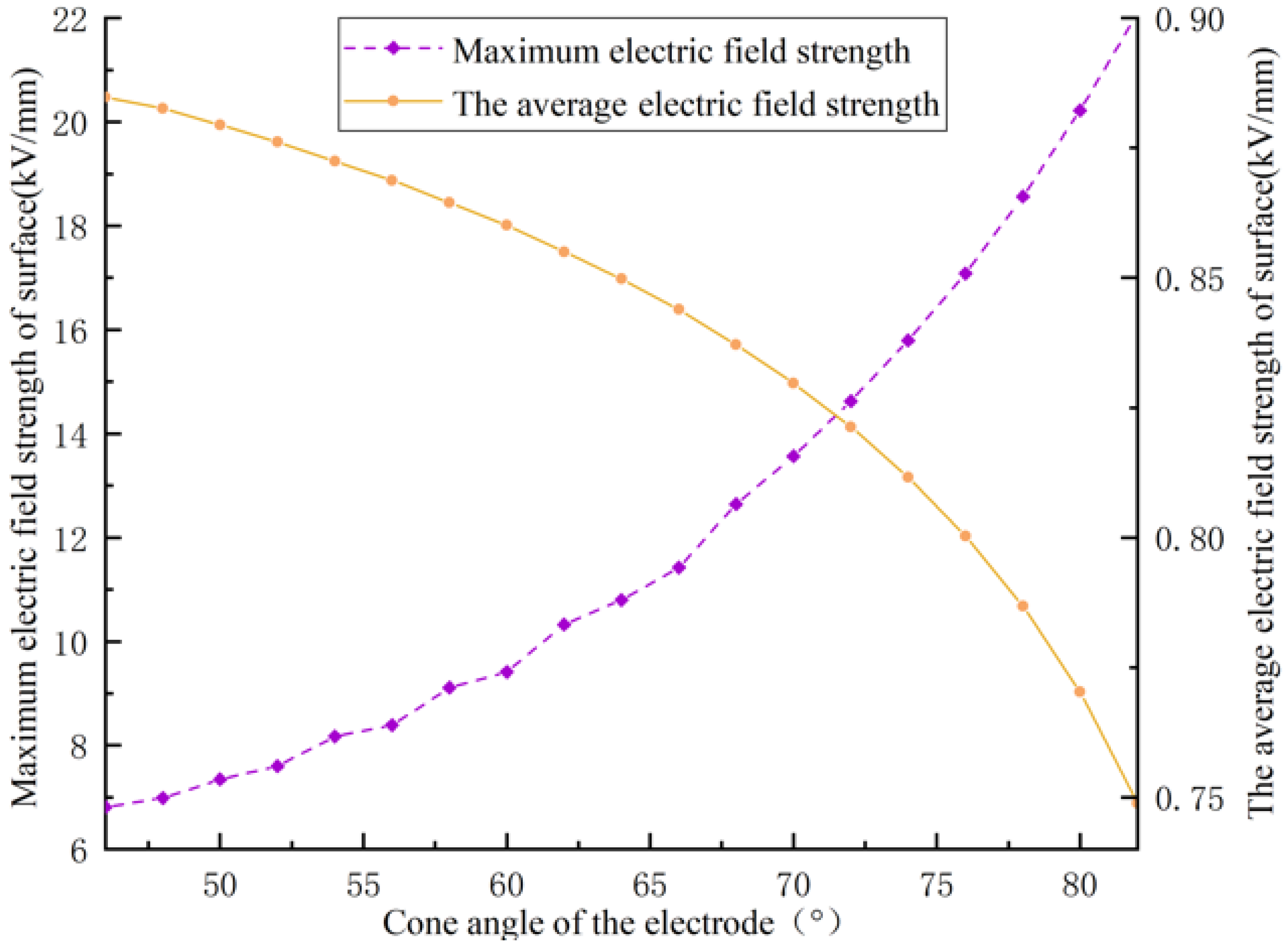
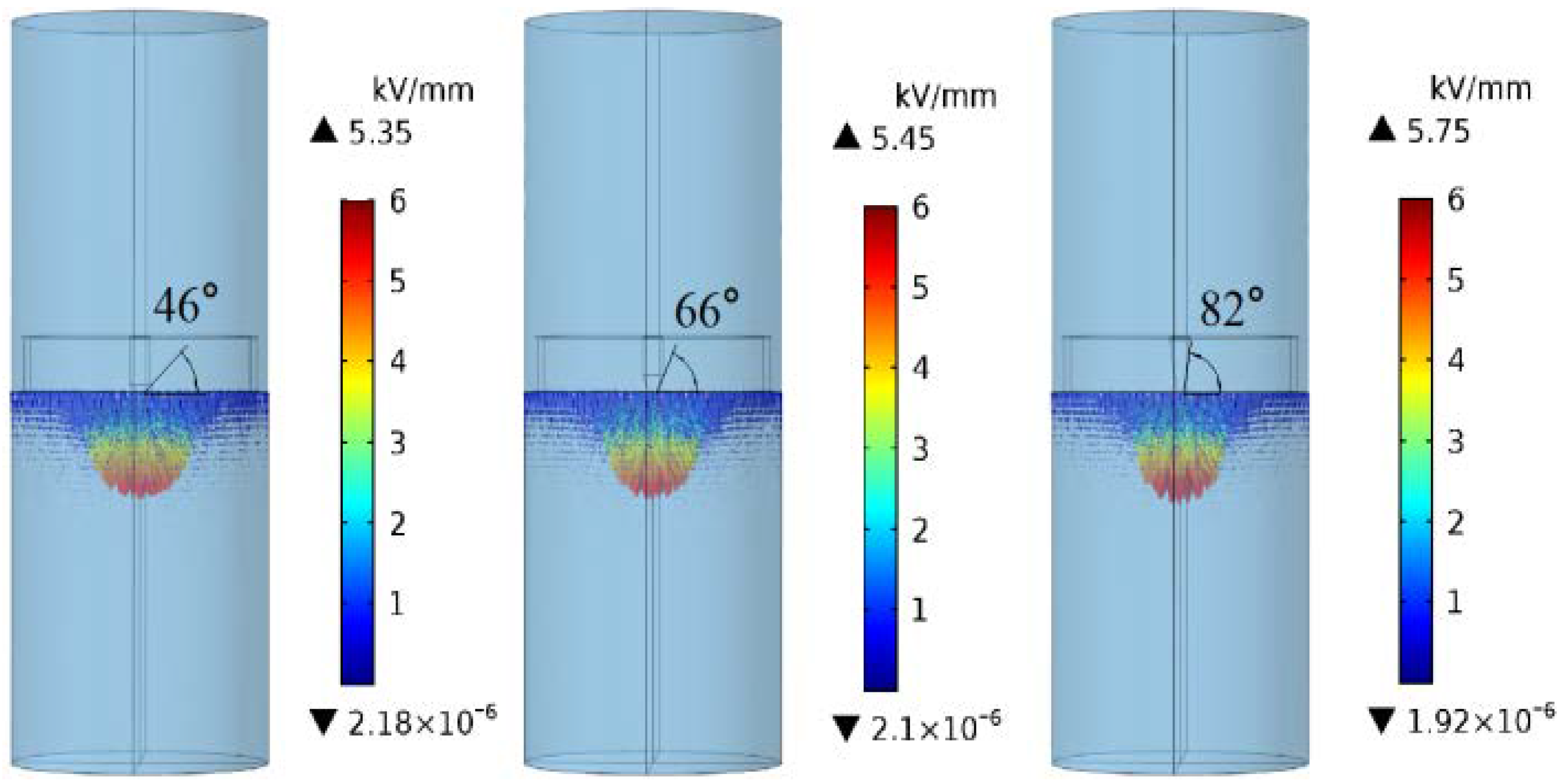
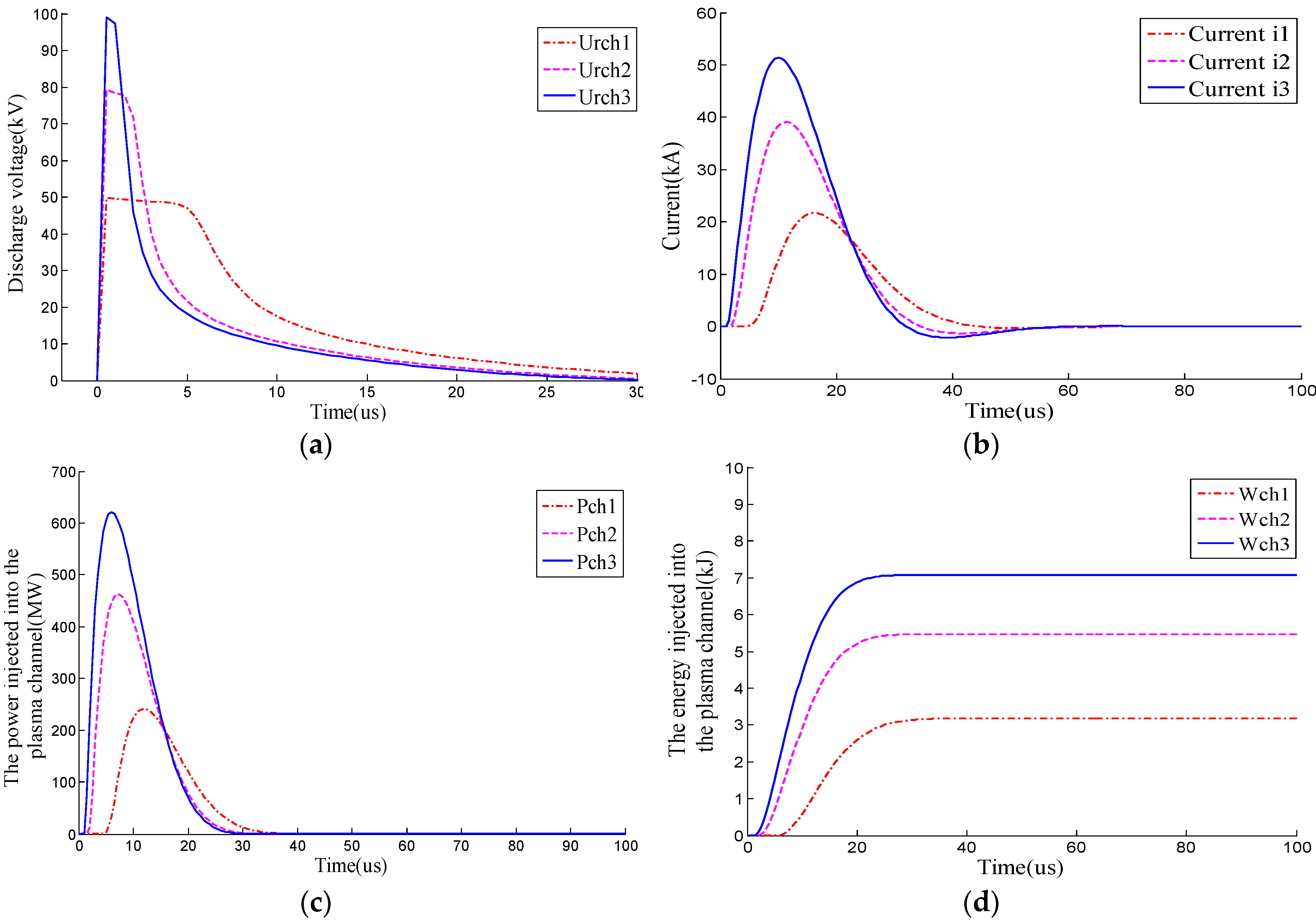
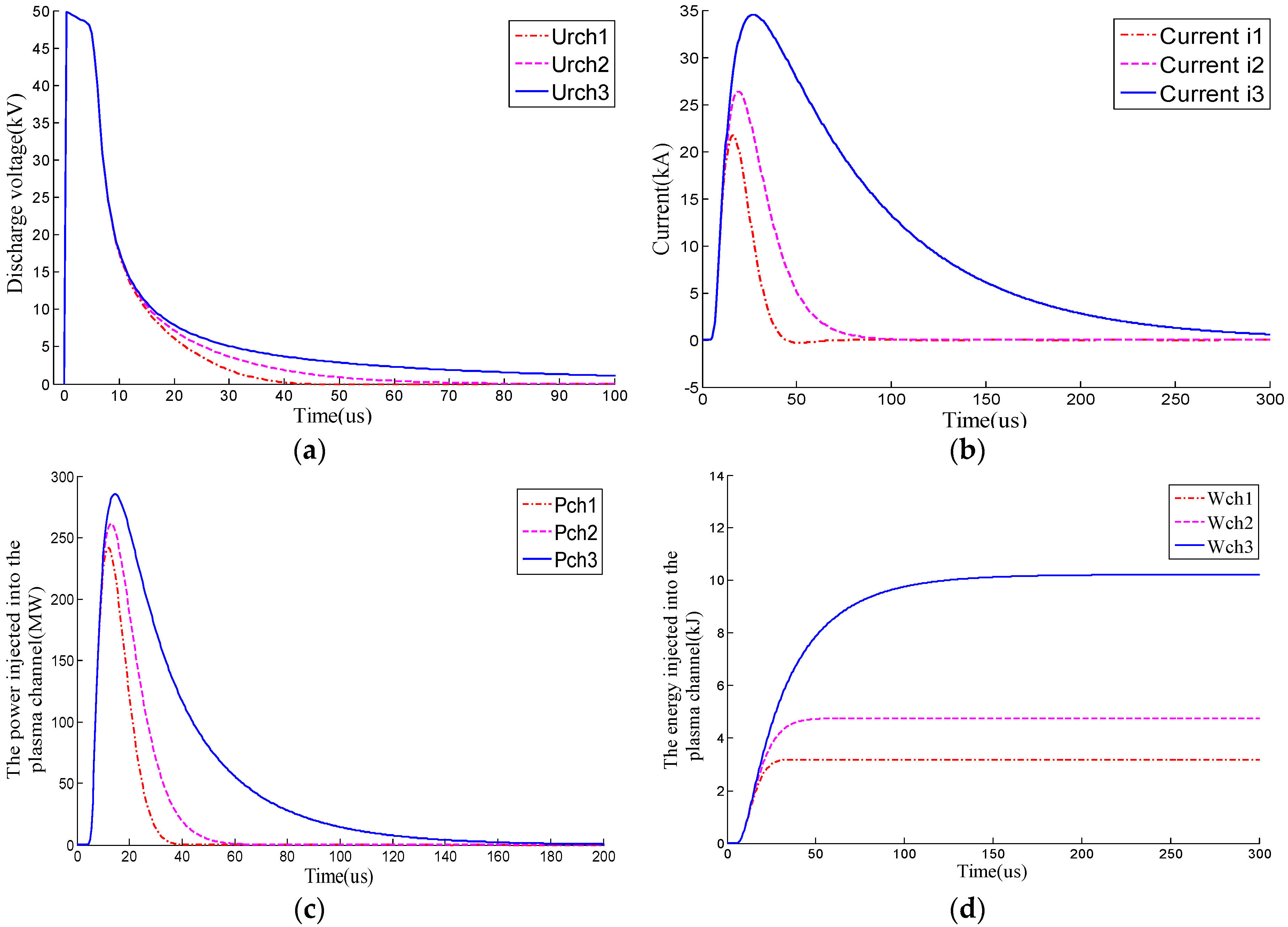
| Material | Electrical Permittivity | Material | Electrical Permittivity |
|---|---|---|---|
| Water | 80 [28] | Potassium feldspar | 6.2 |
| Plagioclase | 6.91 | Quartz | 6.53 |
| Biotite | 9.28 | Magnetite | 65 |
| Charging Voltages | Maximum Energy Storage Capacity | Injected Maximum Power | Injected Maximum Power | Energy Conversion Rate |
|---|---|---|---|---|
| 50 kV | 10 kJ | 241.5 MW | 3.2 kJ | 32% |
| 80 kV | 25.6 kJ | 462.5 MW | 5.5 kJ | 21% |
| 100 kV | 40 kJ | 621.1 MW | 7.1 kJ | 18% |
© 2018 by the authors. Licensee MDPI, Basel, Switzerland. This article is an open access article distributed under the terms and conditions of the Creative Commons Attribution (CC BY) license (http://creativecommons.org/licenses/by/4.0/).
Share and Cite
Li, C.; Duan, L.; Tan, S.; Chikhotkin, V. Influences on High-Voltage Electro Pulse Boring in Granite. Energies 2018, 11, 2461. https://doi.org/10.3390/en11092461
Li C, Duan L, Tan S, Chikhotkin V. Influences on High-Voltage Electro Pulse Boring in Granite. Energies. 2018; 11(9):2461. https://doi.org/10.3390/en11092461
Chicago/Turabian StyleLi, Changping, Longchen Duan, Songcheng Tan, and Victor Chikhotkin. 2018. "Influences on High-Voltage Electro Pulse Boring in Granite" Energies 11, no. 9: 2461. https://doi.org/10.3390/en11092461





